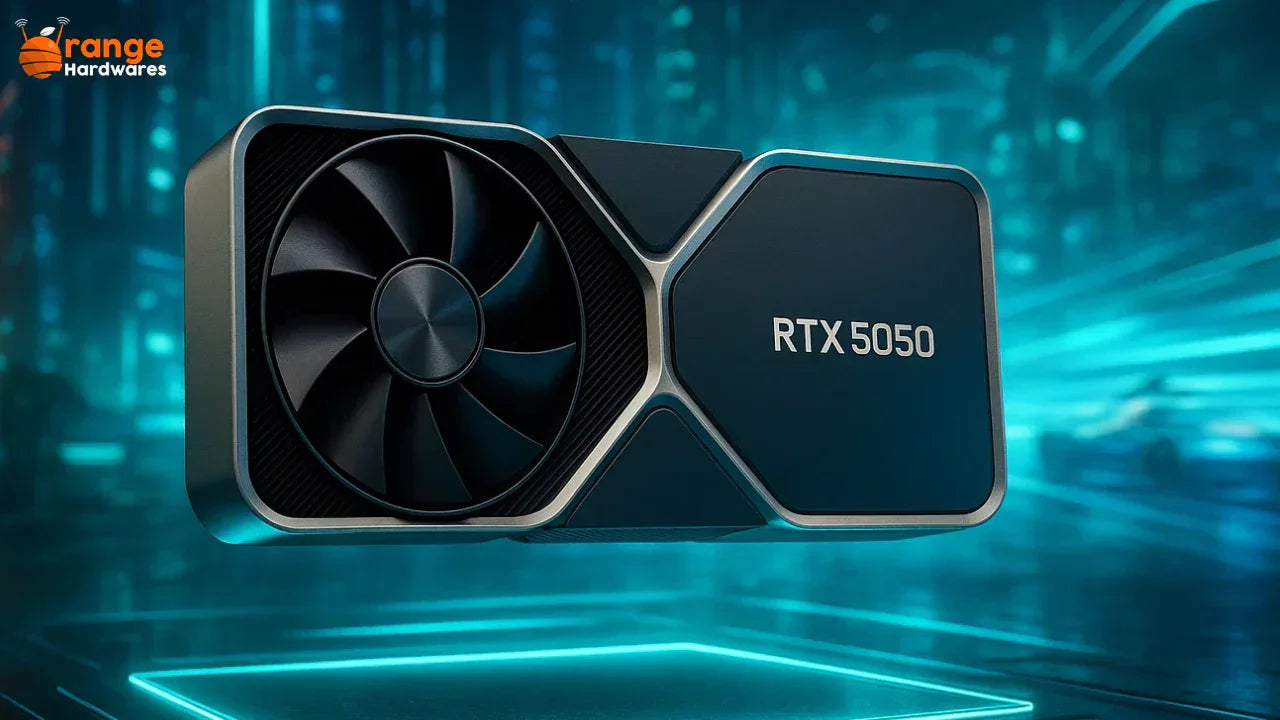The Nvidia GeForce RTX 5050 shows a significant jump for gamers on a budget, combining next-generation performance, plus efficiency through NVIDIA’s Blackwell architecture.
The GPU consists of AI-led enhancements, enhanced ray tracing, and full support for DLSS 4 and Multi-Frame Generation, providing stable 1080p gameplay. Compared to the previous RTX 3050 model, the RTX 5050 features faster clock speeds, more CUDA cores, and increased frame rates in modern games. As part of the latest generation of NVIDIA graphics cards, this guide explores its main specifications, gaming benchmarks, and real-world performance to determine whether the RTX 5050 is a needed upgrade.
It emphasises how the GPU mixes affordability, efficiency, plus modern innovations to help you in making a decision.
The GeForce RTX 5050 Price
The NVIDIA GeForce RTX 5050 price at launch was $249 USD, making it one of the most affordable GPUs in NVIDIA’s latest 50-series graphics cards. Partner variants of the GPU may appear between $269 and $299, in terms of factory overclocks, cooling systems, plus brand design.
In comparison to previous models, this price point gives the RTX 5050 a significant edge for gamers seeking reliable 1080p performance at a budget. The GPU competes directly with AMD’s Radeon RX 7600, plus Intel’s Arc A580, providing better power efficiency and DLSS 4 AI acceleration. At this price, NVIDIA delivers strong value, ensuring high-performance modern gaming capabilities, with an affordable entry price, for next-gen graphics.
Recommended: RTX 5060 vs 5060 Ti - Know Which GPU is Worth Buying
Nvidia GeForce RTX 5050 Specs
The Nvidia GeForce RTX 5050 specs indicate top performance and an increase in efficiency, featuring 2,560 CUDA cores, 20 ray tracing, plus 80 tensor cores. With 8 GB GDDR6 VRAM, 128-bit bus, and 2.57 GHz boost clock, the 5050 GPU delivers strong AI rendering and smooth gameplay at only a 130 W power draw.
Nvidia GeForce RTX 5050 Specifications
|
Specification |
Details |
|
Architecture |
Blackwell GB205 |
|
CUDA Cores |
2,560 |
|
Tensor Cores |
80 |
|
RT Cores |
20 |
|
Base Clock |
2.31 GHz |
|
Boost Clock |
2.57 GHz |
|
VRAM |
8 GB GDDR6 |
|
Memory Bus |
128-bit |
|
Memory Bandwidth |
320 GB/s |
|
TDP / TGP |
130 W |
|
Recommended PSU |
550 W |
|
DLSS Support |
DLSS 4 |
|
Ray Tracing |
2nd Gen Blackwell |
|
Ports |
HDMI 2.1a, DisplayPort 1.4a |
Notably, the laptop variant of the RTX 5050 uses GDDR7 memory for increased power efficiency, while the desktop variant remains on GDDR6 to keep prices at a competitive range. This lets NVIDIA balance performance, thermals, and pricing across both laptops as well as desktop markets.
Nvidia 5050 Performance Benchmarks
The GeForce RTX 5050 Gaming Benchmarks
Looking at user benchmarks, the NVIDIA GeForce RTX 5050 benchmark results confirm that NVIDIA has made significant progress in the entry-level graphics card area. The GPU comes near to RTX 4060 performance in most cases, while often outperforming the older RTX 3060 at 1080p.
Recomended: NVIDIA GeForce RTX 3060 is still worth buying
Gamers can expect between 80 FPS to 120 FPS in most games today at 1080p using high settings with DLSS 4. Even at a 1440p resolution, the RTX 5050 maintains functional frame rates in optimized gaming titles.
|
Game / Benchmark |
Settings / Resolution |
RTX 5050 (Avg FPS) |
|
Cyberpunk 2077 |
1080p Ultra + DLSS 4 |
86 FPS |
|
Doom: The Dark Ages |
1080p Ultra |
110 FPS |
|
Black Myth: Wukong |
1080p High + DLSS Balanced |
93 FPS |
|
Marvel Rivals |
1080p High |
122 FPS |
|
Apex Legends |
1080p High |
157 FPS |
|
Valorant |
1080p High |
188 FPS |
|
Fortnite |
1080p Performance Mode |
162 FPS |
|
3DMark Fire Strike |
Synthetic Test |
27,162 pts |
|
3DMark Time Spy |
Synthetic Test |
9,954 pts |
All in all, the RTX 5050 provides near-mid-range performance at an entry-level. Games like Apex Legends, Valorant, plus Fortnite easily overtake 150 FPS at 1080p, guaranteeing a smooth gaming experience for competitive players or gamers
Geforce 5050 Power Efficiency and Thermal Performance
Power efficiency is one of the strongest parts of the GeForce RTX 5050. Built on Nvidia’s refined Blackwell architecture, the graphics processing unit delivers great performance per watt compared to earlier mid-range graphics cards.
With a 130W thermal design power, it draws notably less power while retaining consistent frame rates in high-end gaming titles.
When it comes to heavy gaming or rendering loads, temperatures usually stay between 68°C and 72°C with a standard dual-fan setup. This ensures stable operation without a lot of extra fan noise, which is great for users who prioritize silent performance, plus energy efficiency.
Main Efficiency Highlights:
- 130W TDP ensures lower power draw and reduced thermal output.
- Maintains cool temperatures between 68°C and 72°C.
- Silent dual-fan cooling system.
- GDDR7 VRAM enhances throughput at lower voltages.
-
Moderate overclocking without major heat increases
Overall, the RTX 5050 achieves a great balance between performance, heat, and power consumption. This makes it a smart choice for gamers and creators looking for efficient and sustainable 5050 GPU performance.
Pros and Cons of RTX 5050
Every GPU has its strengths and drawbacks, including the GeForce RTX 5050, too.
While the card offers brilliant efficiency, next-gen features, plus smooth 1080p performance for modern gaming, it also comes with certain weaknesses that potential buyers should take into account.
The points below show a detailed breakdown of its major advantages and disadvantages to help you make an informed choice before upgrading your GPU setup.
Pros of the 5050 GPU
- Great 1080p performance for the cost
- Supports DLSS 4
- Low energy consumption at 130 W TDP
- Affordable and easy to fit into small systems
- Modern architecture with AI acceleration
Cons of the 5050 GPU
- 8 GB VRAM may restrain future game performance
- Slightly behind the RTX 4060 in some games
- Desktop model uses GDDR6 and not GDDR7
- Modest Overclocking Potential
-
Limited availability at release in some regions
Recommended: How Much VRAM is required for Smooth Gaming at 1080p, 1440p and 4k
Conclusion
If you are planning an upgrade in 2025, this GeForce RTX 5050 review determines why it’s an excellent entry point for modern gameplay. Built on NVIDIA’s Blackwell architecture, the GPU delivers robust 1080p performance with DLSS 4 and enhanced ray tracing at an approachable cost.
The GPU’s power efficiency, compact form, plus thermal output suit it suitable for budget and compact builds. 5050 is not optimized for 1440p gaming, yet it stably handles most games. For users looking to update their graphics cards, the GeForce 5050 provides faster frame rates, better visuals, and next-gen performance, without exceeding budget.
FAQs
Q: Is the RTX 5050 good for gaming?
Yes, it is. The RTX 5050 is a great GPU for 1080p gaming. It manages modern AAA titles, such as Cyberpunk 2077, smoothly with DLSS 4 enabled, and can cross over 100 frames per second (FPS) in competitive games.
Q: How many GB is the RTX 5050?
The desktop version of the RTX 5050 comes with 8 GB of GDDR6 VRAM, while laptop models include GDDR7 for enhanced bandwidth, plus efficiency.
Q: What CPU is needed for RTX 5050?
For the best results, pair the GeForce RTX 5050 with a modern mid-range central processing unit, such as an Intel Core i5-13400F or AMD Ryzen 5 5600 or 7600. These processors provide balanced performance without bottlenecking the graphics processing unit
Q: When did the RTX 5050 come out?
The GeForce RTX 5050 release date was in late July 2025, launching at the same time for desktop, as well as laptop variants, on a global scale.
Q: Does the RTX 5050 have frame generation?
Yes, it does. The RTX 5050 supports DLSS 4 with Multi-Frame Generation, enabling stable gameplay and higher efficiency frame rates in supported gaming titles.
Q: How does the RTX 5050 compare to the 4060?
The RTX 5050 delivers better AI-based features and efficiency; however, the RTX 4060 delivers stronger native gameplay performance without the need for frame generation.

Dedicated Specialists
(855) 703-4322We accept POs from Fortune 1000, government agencies, defense, schools, hospitals, veteran, and women-owned companies.





